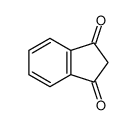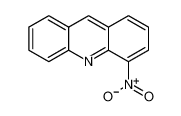1.Identification
1.1 GHS Product identifier
| Product name | acridine |
|---|
1.2 Other means of identification
| Product number | - |
|---|---|
| Other names | Acrydine |
1.3 Recommended use of the chemical and restrictions on use
| Identified uses | For industry use only. |
|---|---|
| Uses advised against | no data available |
1.4 Supplier's details
| Company | MOLBASE (Shanghai) Biotechnology Co., Ltd. |
|---|---|
| Address | Floor 4 & 5, Building 12, No. 1001 North Qinzhou Road, Xuhui District, Shanghai, China |
| Telephone | +86(21)64956998 |
| Fax | +86(21)54365166 |
1.5 Emergency phone number
| Emergency phone number | +86-400-6021-666 |
|---|---|
| Service hours | Monday to Friday, 9am-5pm (Standard time zone: UTC/GMT +8 hours). |
2.Hazard identification
2.1 Classification of the substance or mixture
Acute toxicity - Oral, Category 4
2.2 GHS label elements, including precautionary statements
| Pictogram(s) |  |
|---|---|
| Signal word | Warning |
| Hazard statement(s) | H302 Harmful if swallowed |
| Precautionary statement(s) | |
| Prevention | P264 Wash ... thoroughly after handling. P270 Do not eat, drink or smoke when using this product. |
| Response | P301+P312 IF SWALLOWED: Call a POISON CENTER/doctor/…if you feel unwell. P330 Rinse mouth. |
| Storage | none |
| Disposal | P501 Dispose of contents/container to ... |
2.3 Other hazards which do not result in classification
none
3.Composition/information on ingredients
3.1 Substances
| Chemical name | Common names and synonyms | CAS number | EC number | Concentration |
|---|---|---|---|---|
| acridine | acridine | 260-94-6 | none | 100% |
4.First-aid measures
4.1 Description of necessary first-aid measures
General advice
Consult a physician. Show this safety data sheet to the doctor in attendance.
If inhaled
If breathed in, move person into fresh air. If not breathing, give artificial respiration. Consult a physician.
In case of skin contact
Wash off with soap and plenty of water. Consult a physician.
In case of eye contact
Rinse thoroughly with plenty of water for at least 15 minutes and consult a physician.
If swallowed
Never give anything by mouth to an unconscious person. Rinse mouth with water. Consult a physician.
4.2 Most important symptoms/effects, acute and delayed
Inhalation irritates respiratory system and causes sneezing, crying, and vomiting. Contact with liquid irritates eyes, skin, and mucous membranes. At high temperature and during sun exposure, damage to the cornea, skin, and mucous membranes may occur following the liberation of acridine vapor. (USCG, 1999)
4.3 Indication of immediate medical attention and special treatment needed, if necessary
Minimum/Potential Fatal Human Dose
3. 3= MODERATELY TOXIC: PROBABLE ORAL LETHAL DOSE (HUMAN) 0.5-5 G/KG, BETWEEN 1 OZ & 1 PINT (OR 1 LB) FOR 70 KG PERSON (150 LB).
Absorption, Distribution and Excretion
ACRIDINE WAS RAPIDILY ACCUM FROM WATER BY FATHEAD MINNOWS. EQUIL CONCN WITHIN 24 HR @ CONCN FACTOR ((ACRIDINE)FISH,WET WT/(ACRIDINE)WATER) OF 125 +/- 10. DEPURATION WAS RAPID. NET ELIMINATION RATE WAS 0.23/HR (ACRIDINE)FISH @ EQUILIBRIUM.
5.Fire-fighting measures
5.1 Extinguishing media
Suitable extinguishing media
If material on fire or involved in fire: Use water in flooding quantities as fog. Use "alcohol" foam, dry chemical or carbon dioxide. Cool all affected containers with flooding quantities of water. Apply water from as far a distance as possible. Keep run-off water out of sewers and water sources.
5.2 Specific hazards arising from the chemical
Special Hazards of Combustion Products: Toxic oxides of nitrogen may form in fire. Behavior in Fire: Sublimes before melting (USCG, 1999)
5.3 Special protective actions for fire-fighters
Wear self-contained breathing apparatus for firefighting if necessary.
6.Accidental release measures
6.1 Personal precautions, protective equipment and emergency procedures
Use personal protective equipment. Avoid dust formation. Avoid breathing vapours, mist or gas. Ensure adequate ventilation. Evacuate personnel to safe areas. Avoid breathing dust. For personal protection see section 8.
6.2 Environmental precautions
Prevent further leakage or spillage if safe to do so. Do not let product enter drains. Discharge into the environment must be avoided.
6.3 Methods and materials for containment and cleaning up
Pick up and arrange disposal. Sweep up and shovel. Keep in suitable, closed containers for disposal.
7.Handling and storage
7.1 Precautions for safe handling
Avoid contact with skin and eyes. Avoid formation of dust and aerosols. Avoid exposure - obtain special instructions before use.Provide appropriate exhaust ventilation at places where dust is formed. For precautions see section 2.2.
7.2 Conditions for safe storage, including any incompatibilities
...MATERIALS WHICH ARE TOXIC AS STORED OR WHICH CAN DECOMPOSE INTO TOXIC COMPONENTS...SHOULD BE STORED IN A COOL, WELL VENTILATED PLACE, OUT OF THE DIRECT RAYS OF THE SUN, AWAY FROM AREAS OF HIGH FIRE HAZARD, AND SHOULD BE PERIODICALLY INSPECTED. INCOMPATIBLE MATERIALS SHOULD BE ISOLATED...
8.Exposure controls/personal protection
8.1 Control parameters
Occupational Exposure limit values
no data available
Biological limit values
no data available
8.2 Appropriate engineering controls
Handle in accordance with good industrial hygiene and safety practice. Wash hands before breaks and at the end of workday.
8.3 Individual protection measures, such as personal protective equipment (PPE)
Eye/face protection
Safety glasses with side-shields conforming to EN166. Use equipment for eye protection tested and approved under appropriate government standards such as NIOSH (US) or EN 166(EU).
Skin protection
Wear impervious clothing. The type of protective equipment must be selected according to the concentration and amount of the dangerous substance at the specific workplace. Handle with gloves. Gloves must be inspected prior to use. Use proper glove removal technique(without touching glove's outer surface) to avoid skin contact with this product. Dispose of contaminated gloves after use in accordance with applicable laws and good laboratory practices. Wash and dry hands. The selected protective gloves have to satisfy the specifications of EU Directive 89/686/EEC and the standard EN 374 derived from it.
Respiratory protection
Wear dust mask when handling large quantities.
Thermal hazards
no data available
9.Physical and chemical properties
| Physical state | colourless to light yellow crystals |
|---|---|
| Colour | RHOMBOHEDRAL NEEDLES OR PRISMS FROM ALCOHOL; MONOCLINIC, ORTHORHOMBIC |
| Odour | no data available |
| Melting point/ freezing point | 189°C(lit.) |
| Boiling point or initial boiling point and boiling range | 61°C/12mmHg(lit.) |
| Flammability | no data available |
| Lower and upper explosion limit / flammability limit | no data available |
| Flash point | 65°C(lit.) |
| Auto-ignition temperature | no data available |
| Decomposition temperature | no data available |
| pH | A WEAK BASE, COLORS LITMUS PAPER BLUE |
| Kinematic viscosity | no data available |
| Solubility | SLIGHTLY SOL IN HOT WATER; VERY SOL IN ALCOHOL, ETHER, BENZENE AND CARBON DISULFIDE |
| Partition coefficient n-octanol/water (log value) | Log P= 3.40 |
| Vapour pressure | 0.000113mmHg at 25°C |
| Density and/or relative density | 1.005 |
| Relative vapour density | no data available |
| Particle characteristics | no data available |
10.Stability and reactivity
10.1 Reactivity
no data available
10.2 Chemical stability
VOLATILE WITH STEAM
10.3 Possibility of hazardous reactions
ACRIDINE neutralizes acids in exothermic reactions to form salts plus water. May be incompatible with isocyanates, halogenated organics, peroxides, phenols (acidic), epoxides, anhydrides, and acid halides. Flammable gaseous hydrogen may be generated in combination with strong reducing agents, such as hydrides. Burns to give toxic oxides of nitrogen.
10.4 Conditions to avoid
no data available
10.5 Incompatible materials
STABILITY: This chemical undergoes photo-oxidation after irradiation in indoor sunlight or by fluorescent light in organic solvents. Solutions of this chemical in benzene oxidize under the influence of light and air. Solutions of this chemical in water, DMSO, 95% ethanol or acetone should be stable for 24 hours under normal lab conditions.REACTIVITY: This chemical is incompatible with strong oxidizers. It readily undergoes nitration and halogenation. Ozone, chromic acid and chlorinating agents oxidize this compound. This chemical may react with organic and inorganic oxidants including various electrophiles, peroxides, nitrogen oxides and sulfur oxides. Hydrogenation occurs with platinum oxide.
10.6 Hazardous decomposition products
WHEN HEATED TO DECOMPOSITION, ACRIDINE EMITS TOXIC FUMES.
11.Toxicological information
Acute toxicity
- Oral: no data available
- Inhalation: no data available
- Dermal: no data available
Skin corrosion/irritation
no data available
Serious eye damage/irritation
no data available
Respiratory or skin sensitization
no data available
Germ cell mutagenicity
no data available
Carcinogenicity
EPA-B2, IARC-1, NIOSH-Ca, NTP-R, TLV-A2
Reproductive toxicity
no data available
STOT-single exposure
no data available
STOT-repeated exposure
no data available
Aspiration hazard
no data available
12.Ecological information
12.1 Toxicity
- Toxicity to fish: no data available
- Toxicity to daphnia and other aquatic invertebrates: no data available
- Toxicity to algae: no data available
- Toxicity to microorganisms: no data available
12.2 Persistence and degradability
The biodegradation of acridine at concentrations from 0.1 to 20 mg/l was measured in river die-away tests using Green River water; over 11 days this compound was not significantly biodegraded at any measured concentration(1). Acridine at 500 mg/kg soil was measurably present for 83 days in chernozem soil samples at a temperature of 19°C(2). A half-life of 3 days in soil was reported for acridine when present at a concentration of 5 mg/kg(3). Acridine, initially present in a groundwater sample at 22.5 ug/ml, was inoculated with creosote-contaminated surface soil; 19, 37, 91.5, 91, and 91% of this compound was biodegraded following 1, 3, 5, 8, and 14 days incubation(4). The sterile control was not degraded over 14 days(4). During solid-phase bioremediation of creosote/PCP contaminated surface soils, unamended soils, containing acridine initially at 46.8 mg/landfarming chamber (3 kg) biodegraded this compound by 83% over 12 weeks(5). In similar experiments using surficial soil, 32% biodegradation was reported over 12 weeks with an initial acridine concentration of 14569.7 mg/landfarming chamber (3 kg)(5). The presence of 9-acridinone in groundwater samples possibly indicates that this compound may be the final product of the biodegradation of acridine in contaminated aquifers(6).
12.3 Bioaccumulative potential
In a static bioconcentration test, a BCF value of 1300 was measured in the guppy, Poecilia reticulata(1). Rate constants for uptake and depuration were 40.8 and 0.031/hour, respectively(1). An equilibrium BCF of 30 was measured for acridine in Daphnia pulex; rate constants for uptake and depuration were 109.6 and 0.47/hour, respectively(2). A BCF value of 126 was measured in fathead minnows(3). Fathead minnows, exposed to 100 ug/L acridine in a flow-through spring water system, rapidly accumulated acridine directly from the water with concentrations of about 12 ug/g wet attained in the fish after 24 hours giving a BCF of 125(4). Further exposure did not result in higher levels of acridine in these fish(4). Rate constants for uptake and depuration were 14 and 0.112/hour, respectively(4). Uncontaminated water rapidly contained measurable concentrations of acridine once minnows containing this compound were added to the water; this suggests that acridine can be eliminated without metabolic alteration as well as through metabolic degradation(4). Minnows exposed to acridine-contaminated sediment and a low level of dissolved acridine did not accumulate much acridine from the sediment(4). According to a classification scheme(5), these BCF values suggest that bioconcentration in aquatic organisms is low to very high depending on the aquatic organism studied(SRC); however, this compound appears to be readily depurated in several organisms. Mussels, Elliptio complanata, did not accumulate detectable concentrations of acridine following three weeks exposure to contaminated sediments in the St. Mary's River in 1985 (detection limit= 1 ug/kg wet weight)(6).
12.4 Mobility in soil
Fourteen soil and sediment samples, collected from the Ohio, Missouri, Mississippi, and Illinois rivers and their watersheds had a wide range in pH (4.54-8.34), total clay (6.8 to 69.1%), organic carbon (0.11 to 2.38%), and expanding clay (2.0 to 60.0%). Koc values for acridine added to these soils/sediments ranged from 5500 to 30,909 with an average value of 12,910(1). According to a recommended classification scheme(2), these measured Koc values suggest that acridine will be immobile in soil(SRC). Adsorption of acridine to silica was measured in a continuous-flow column. The extent of adsorption was greater when the solution pH was below the pKa of acridine(pKa= 5.68(3)) than when it was above(4). Therefore, mobility should be greater in a sand soil when the pH is above the pKa of acridine and adsorption is greatest when the solution pH equals acridine's pKa(4). Sorption of acridine to two low organic carbon subsurface materials with similar properties but different equilibrium pH values when saturated with water was measured(5). Higher sorption was reported for the Loring subsoil (0.24% organic carbon, pH 4.85) than the Anvil Points subsoil (0.58% organic carbon, pH 8.15), consistent with compound ionization and preferential retention of the organic cation over the neutral compound(5).
12.5 Other adverse effects
no data available
13.Disposal considerations
13.1 Disposal methods
Product
The material can be disposed of by removal to a licensed chemical destruction plant or by controlled incineration with flue gas scrubbing. Do not contaminate water, foodstuffs, feed or seed by storage or disposal. Do not discharge to sewer systems.
Contaminated packaging
Containers can be triply rinsed (or equivalent) and offered for recycling or reconditioning. Alternatively, the packaging can be punctured to make it unusable for other purposes and then be disposed of in a sanitary landfill. Controlled incineration with flue gas scrubbing is possible for combustible packaging materials.
14.Transport information
14.1 UN Number
| ADR/RID: UN2713 | IMDG: UN2713 | IATA: UN2713 |
14.2 UN Proper Shipping Name
| ADR/RID: ACRIDINE |
| IMDG: ACRIDINE |
| IATA: ACRIDINE |
14.3 Transport hazard class(es)
| ADR/RID: 6.1 | IMDG: 6.1 | IATA: 6.1 |
14.4 Packing group, if applicable
| ADR/RID: III | IMDG: III | IATA: III |
14.5 Environmental hazards
| ADR/RID: no | IMDG: no | IATA: no |
14.6 Special precautions for user
no data available
14.7 Transport in bulk according to Annex II of MARPOL 73/78 and the IBC Code
no data available
15.Regulatory information
15.1 Safety, health and environmental regulations specific for the product in question
| Chemical name | Common names and synonyms | CAS number | EC number |
|---|---|---|---|
| acridine | acridine | 260-94-6 | none |
| European Inventory of Existing Commercial Chemical Substances (EINECS) | Listed. | ||
| EC Inventory | Listed. | ||
| United States Toxic Substances Control Act (TSCA) Inventory | Listed. | ||
| China Catalog of Hazardous chemicals 2015 | Listed. | ||
| New Zealand Inventory of Chemicals (NZIoC) | Listed. | ||
| Philippines Inventory of Chemicals and Chemical Substances (PICCS) | Listed. | ||
| Vietnam National Chemical Inventory | Not Listed. | ||
| Chinese Chemical Inventory of Existing Chemical Substances (China IECSC) | Listed. | ||
16.Other information
Information on revision
| Creation Date | Aug 11, 2017 |
|---|---|
| Revision Date | Aug 11, 2017 |
Abbreviations and acronyms
- CAS: Chemical Abstracts Service
- ADR: European Agreement concerning the International Carriage of Dangerous Goods by Road
- RID: Regulation concerning the International Carriage of Dangerous Goods by Rail
- IMDG: International Maritime Dangerous Goods
- IATA: International Air Transportation Association
- TWA: Time Weighted Average
- STEL: Short term exposure limit
- LC50: Lethal Concentration 50%
- LD50: Lethal Dose 50%
- EC50: Effective Concentration 50%
References
- IPCS - The International Chemical Safety Cards (ICSC), website: http://www.ilo.org/dyn/icsc/showcard.home
- HSDB - Hazardous Substances Data Bank, website: https://toxnet.nlm.nih.gov/newtoxnet/hsdb.htm
- IARC - International Agency for Research on Cancer, website: http://www.iarc.fr/
- eChemPortal - The Global Portal to Information on Chemical Substances by OECD, website: http://www.echemportal.org/echemportal/index?pageID=0&request_locale=en
- CAMEO Chemicals, website: http://cameochemicals.noaa.gov/search/simple
- ChemIDplus, website: http://chem.sis.nlm.nih.gov/chemidplus/chemidlite.jsp
- ERG - Emergency Response Guidebook by U.S. Department of Transportation, website: http://www.phmsa.dot.gov/hazmat/library/erg
- Germany GESTIS-database on hazard substance, website: http://www.dguv.de/ifa/gestis/gestis-stoffdatenbank/index-2.jsp
- ECHA - European Chemicals Agency, website: https://echa.europa.eu/
























